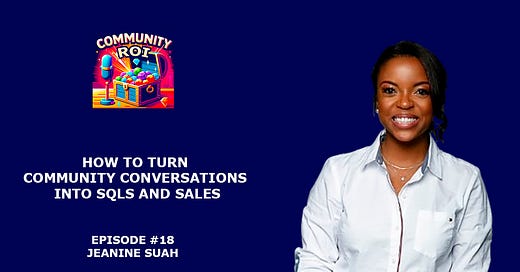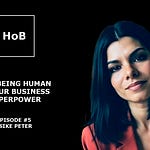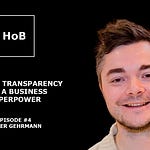“You have to be like, okay, as a community builder, what am I not getting about what the CEO wants to see? Okay. All I'm hearing is numbers, numbers, numbers. What do I have to learn from that?
And in the same tone as an executive, all I'm hearing are these community people talking about vibes and events and content and value and all this amazing stuff. Like what am I not understanding?
And so the first is when you can meet people where they are and truly remove ego and remove self from the situation and take a step back and be like, all right, hold on, what can I actually learn from this? A lot can happen, and that's where the bridge comes into play.
And then the second thing is find somebody, I call them experts in residents or xrs, but find somebody who can speak both languages. Who can then become the bridge across these different departments.”
From this episode, you'll know:
👉 Real power of language in breaking down barriers between founders, VCs, and internal stakeholders.
👉 Role of community as a “cheat code” to reduce CAC, lower churn, and increase LTV.
👉 Why do you need to balance business intuition with human empathy to define community goals.
👉 How internal community champions can bridge the gap across content, marketing, sales, and growth.
👉 Framework for tracking community-driven outcomes and translating them into measurable business value.
Choose the best platform to listen to this episode:
Connect with Jeanine and Yurii here:
https://www.linkedin.com/in/jeaninesuah/
https://www.linkedin.com/in/yurii-lazaruk-community-consultant/
The Language of Community: Turning Shared Energy Into Real Business ROI
In the fast-evolving world of business growth, the term "community" has become both a buzzword and a blind spot. While many leaders intuitively recognize its value, few truly understand how to translate community engagement into tangible business outcomes.
That’s not because community doesn't drive ROI, but because the connection often gets lost in translation.
The truth is: community is strategy.
But its strategy is written in a different language—one that's emotional, relational, and driven by trust, not just transactions.
Redefining Community for Business
At its core, a business community is a shared group of people united by a common understanding and a collective vision.
It's not about brand loyalty or endless Slack channels. It’s about co-creating value together. When that shared vision aligns with business goals, community becomes a powerful growth engine.
But here's the challenge: community builders speak in terms of belonging, engagement, and relationships. Executives, meanwhile, speak in metrics—CAC, LTV, SQLs. This disconnect often makes it feel like the community team is defending their existence instead of proving their value.
The solution? Translate. Learn both languages.
The Power of Translation
Language is more than words—it’s access. When you speak to someone in their native tongue, the emotional connection deepens. The same applies internally.
Community professionals must become fluent in both the language of human connection and the language of business value.
This doesn’t mean changing the story. It means reframing it. Instead of saying, “We hosted an amazing event,” say, “We reduced CAC by 40% through strategic in-person activations that led to 68 qualified leads in six days.”
Same effort. Different framing. Greater clarity. Bigger budget.
Community as the Cheat Code
Community is often the most underutilized and underestimated tool in the go-to-market strategy. When done right, it informs product, improves marketing, amplifies sales, and unlocks user insights faster than any survey or analytics platform could.
Why? Because community is direct feedback at scale.
The people closest to your product—the users, customers, and partners—will tell you what’s working and what’s broken. But only if they trust you. And that trust is built through ongoing, honest, and consistent engagement, not sporadic campaigns or transactional check-ins.
When done well, community reduces customer acquisition costs, lowers churn, and increases lifetime value. It does this not through gimmicks, but through relationships that compound over time.
Proving the ROI (Without Burning Out)
The hardest part isn’t delivering ROI—it’s showing it. Community ROI has a long-term impact, and leadership often prioritizes short-term numbers.
The key is to design small, intentional experiments with measurable outcomes.
Run office hours. Track attendance. Post recaps. Measure link clicks. Tie it all back to engagement and pipeline movement. Use the same tools your marketing and sales teams already use—Salesforce, HubSpot, UTM tracking—and meet them where they are.
If you can prove just one conversion from community-led actions, the path forward becomes exponentially easier. Don’t try to boil the ocean. Prove the pond first.
The Role of the Bridge
Every company needs a "bridge"—someone who can communicate effectively with both the community and executives. Someone who understands that a founder might say, “I want more SQLs,” while a community builder says, “Let’s create deeper engagement.” They’re often talking about the same thing, but don’t realize it.
A successful community function doesn’t sit on the sidelines. It flows horizontally across the company. It influences marketing, partners with sales, and informs product, all while staying rooted in the needs and voices of real people.
But to get there, the team needs translators. People who can reframe outcomes, not compromise values.
Start Small, Start Now
If you're struggling to show the business value of your community, don’t wait for permission or perfection.
Publish a simple post. Ask for feedback. Track responses. Start conversations. Listen deeply.
And remember: you don’t need to talk to everyone. You need to talk to the right people in the right language.
When your message lands, your results will follow 🤗















Share this post